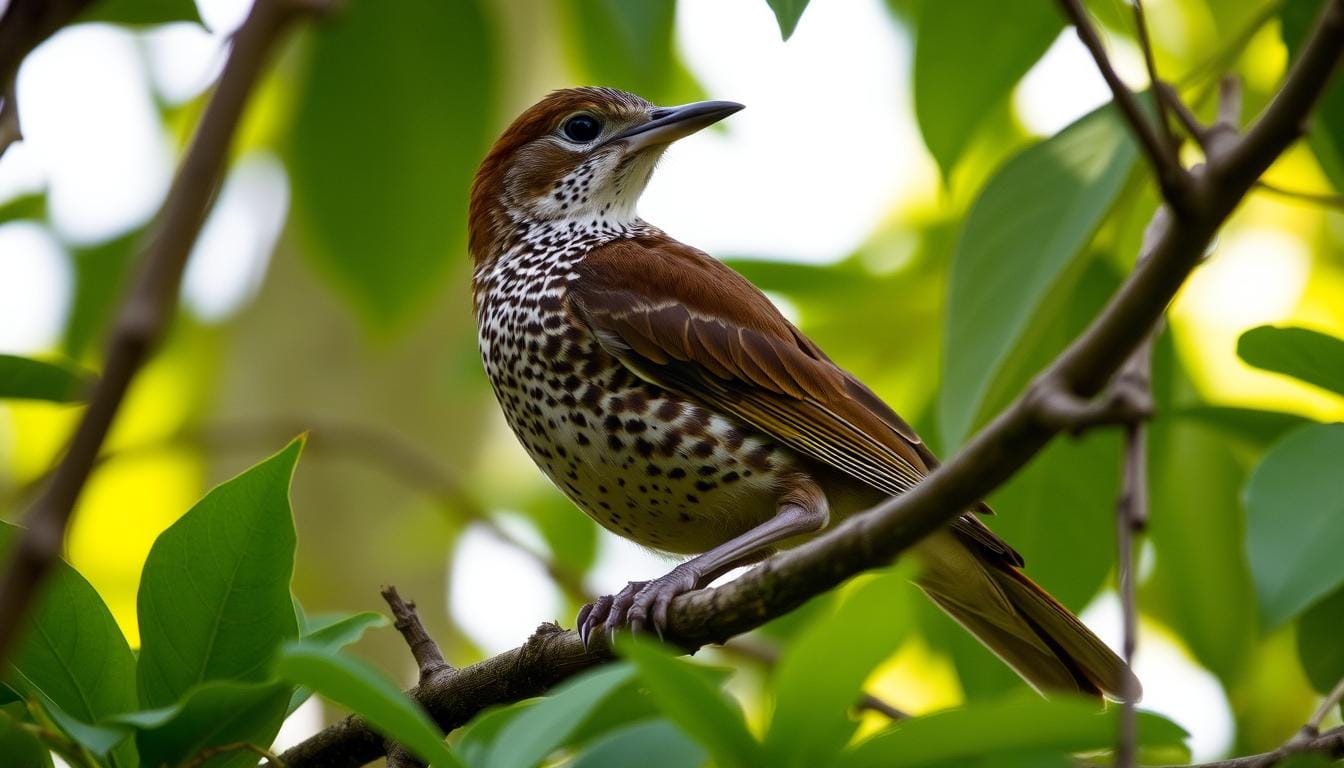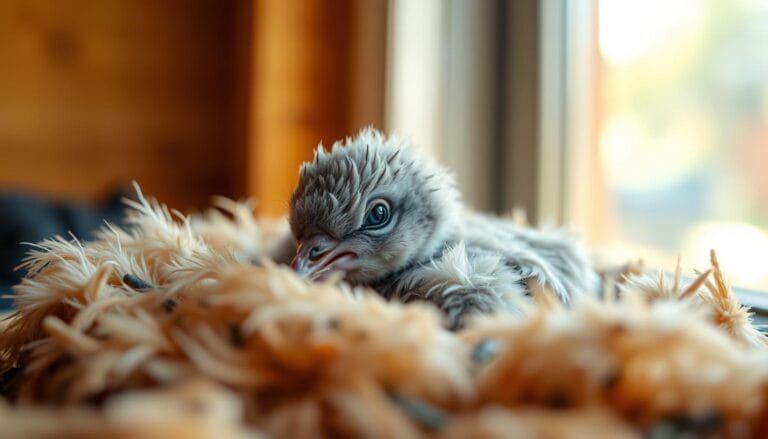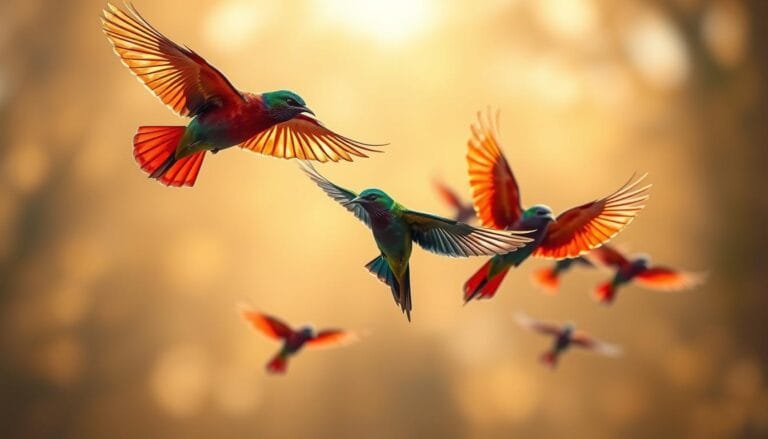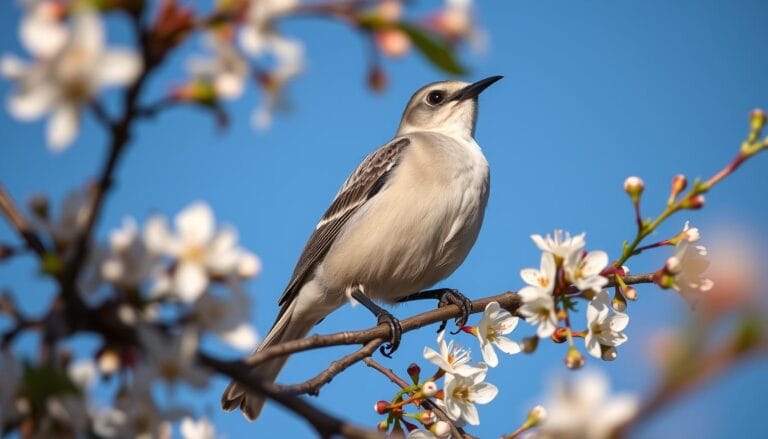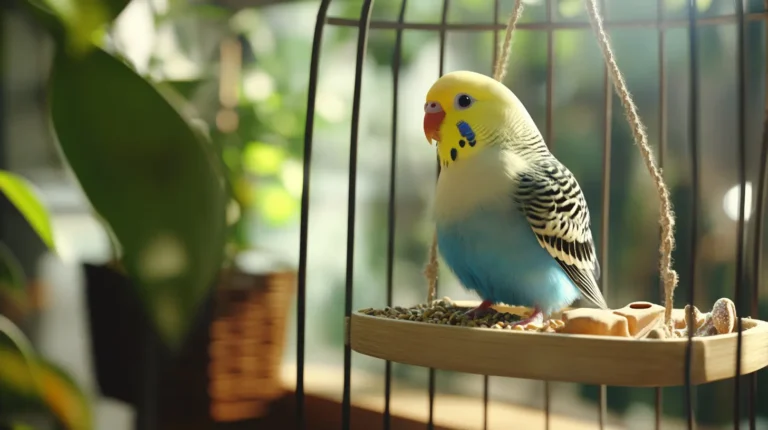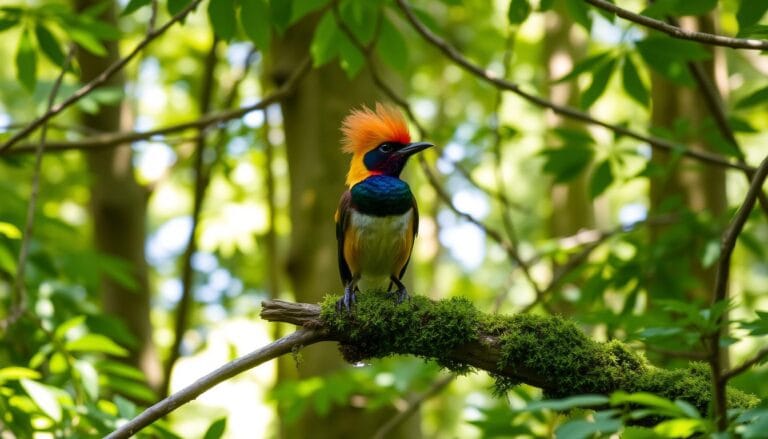Brown Thrasher Bird: Discover Stunning Speckled Species
Did you know the Brown Thrasher bird can mimic over 1,100 songs? This brown speckled bird is known for its unique pattern and amazing singing skills. As you learn about brown bird species, you’ll find the Brown Thrasher bird is quite interesting. It belongs to the Mimidae family.
Table of Contents
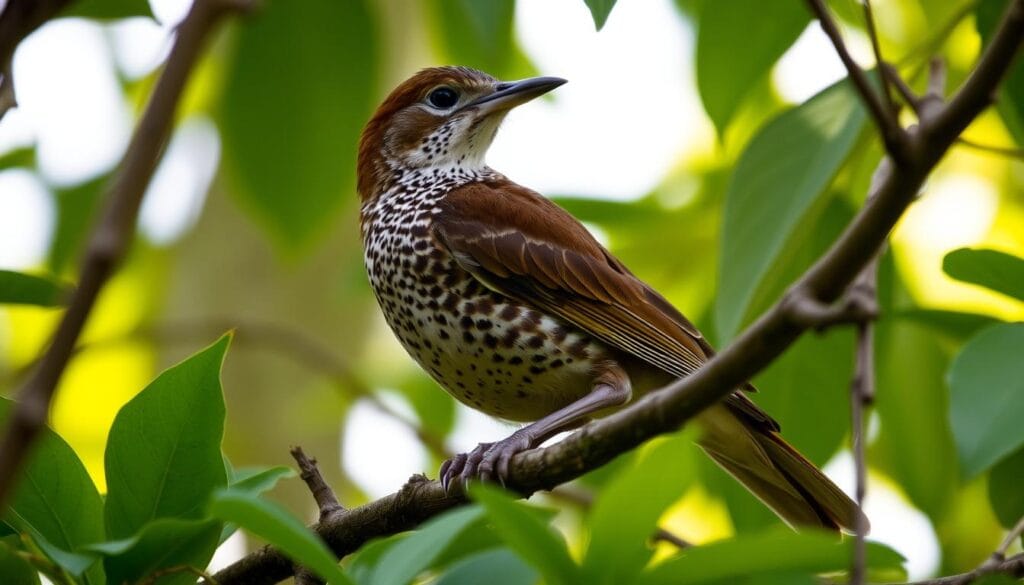
This article will tell you about the Brown Thrasher’s looks, where it lives, how it acts, what it eats, and its conservation status. You’ll also learn how to tell it apart from other birds. It’s a great guide for anyone interested in brown bird species, including those in Florida.
Key Takeaways
- The Brown Thrasher is a brown bird species with a distinctive speckled pattern
- It can mimic over 1,100 different song variations
- The Brown Thrasher is a member of the Mimidae family
- It inhabits semi-open habitats, including forest edges and shrubby fields
- The Brown Thrasher’s diet includes insects, seeds, berries, and small animals
- It is highly territorial and defends its space with loud, varied calls
Physical Characteristics of the Brown Thrasher Bird
The Brown Thrasher Bird is a large songbird with unique features. It has a reddish-brown back and white underside with a speckled pattern. This pattern makes it stand out among other brown birds in Florida.
It is slightly smaller than a Blue Jay but larger than a Northern Mockingbird. This size and shape are key to identifying it.
This bird has a long, slightly curved bill and bright yellow eyes. Its long tail and sturdy legs are also distinctive. Some key features of the Brown Thrasher Bird include:
- A reddish-brown upper body with heavy dark streaking on its whitish underparts
- A long, slightly curved bill
- Bright yellow eyes
- A long tail and sturdy legs
These features make the Brown Thrasher Bird unique and fascinating. It is a notable sight in Florida, thanks to its speckled pattern and robust build.
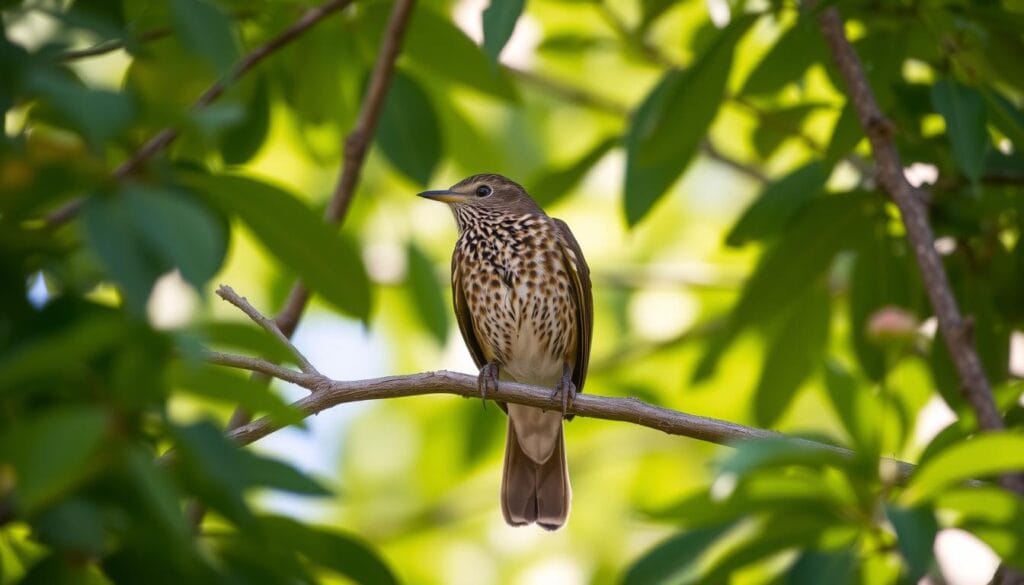
Distinctive Speckled Pattern
The Brown Thrasher Bird‘s speckled pattern is one of its most distinctive features. This pattern, along with its size and shape, makes it a notable species in Florida.
Natural Habitat and Distribution
Exploring the world of brown thrashers and doves reveals their diverse habitats. The brown thrasher thrives in scrubby fields, dense woods, and forest edges. It’s a common sight in central and eastern North America.
These birds adapt well to different environments. They can be found in urban backyards and rural forests. This adaptability makes them easy to spot in various places.
Let’s look at some key facts about their distribution:
- Breeding observations of brown thrashers account for only 3% of total observations.
- Confirmed breeding evidence constitutes 16% of observations, with the largest concentration in the Pineywoods region.
- The northeastern corner of Texas and the northeastern Panhandle are also notable breeding areas.
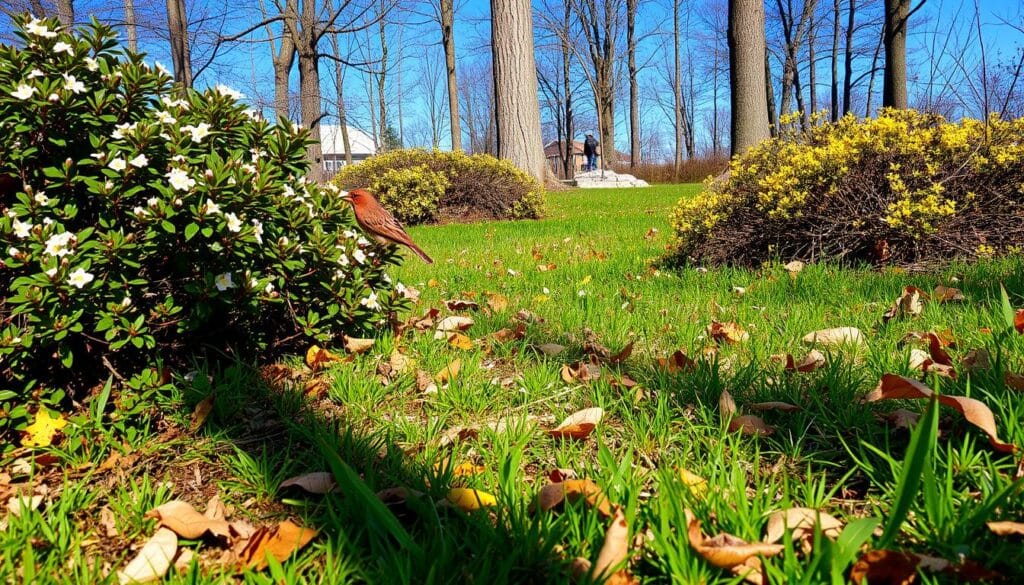
Brown thrashers and doves are found across North America. In Texas, the brown thrasher breeding range covers about 1% of its North American territory. Knowing their habitats helps you spot these birds in the wild.
The Brown Thrasher’s Unique Behaviors
The Brown Thrasher is a special bird in the brown bird species. It has interesting ways of finding food. It looks for insects and other small creatures on the ground and in trees. This is something many brown speckled bird species do, showing how they’ve adapted to their homes.
This bird also defends its territory very strongly. It fights off other Brown Thrashers and different bird species. This is important for its survival and shows a key part of its behavior.
- Foraging techniques: searching for insects and invertebrates on the ground and in trees
- Territorial defense: defending its territory against other Brown Thrashers and species
- Mating rituals: complex courtship behaviors and songs
These behaviors help the Brown Thrasher survive. They show how adaptable and special this brown speckled bird species is.
Distinguishing Brown Thrashers from Similar Species
Exploring the world of brown birds, you might see birds that look like brown thrashers. To tell a brown thrasher apart, look for its speckled pattern and long, curved bill. These features make it stand out from other birds.
When comparing brown thrashers and doves, notice their physical differences. Brown thrashers have a speckled chest, while brown doves are more uniform in color. Brown thrashers also have long, curved bills, great for finding and eating insects.
- Distinctive speckled pattern on their chest and belly
- Long, curved bill perfect for foraging and eating insects
- Brown bird with speckled chest, unlike the uniform brown color of brown doves
By recognizing these unique features, you can spot a brown thrasher easily. Whether you’re a birdwatching pro or just starting, knowing the differences between brown thrashers and doves will make your birding adventures better.
Diet and Feeding Patterns
As you explore the world of brown birds in florida, you might wonder what they eat. The Brown Thrasher, a common brown bird species, eats a variety of foods. In spring, they mainly eat insects like beetles and grasshoppers.
In fall, acorns are a big favorite. They often hit them on the ground. They also eat fruits like blueberries and blackberries, more so in summer when they’re easier to find.
Some of the key food sources for Brown Thrashers include:
- Insects: beetles, crickets, caterpillars, and ants
- Fruits: blueberries, elderberries, pokeberries, and blackberries
- Seeds: sunflower seeds, peanuts, and cracked corn
Brown Thrashers search for food on the ground and in trees. They use their long, curved bill to find invertebrates and small animals. They eat insects often, even when they’re not raising young.
Brown Thrasher Songs and Vocalizations
The brown speckled bird, also known as the brown bird with speckled chest, is famous for its complex songs. It can sing over 3,000 songs, with up to 1,116 different types. This is more than the northern mockingbird, which sings over 200 songs.
One special thing about the brown thrasher’s song is how it repeats. Unlike the northern mockingbird, which sings the same song three times or more, the brown thrasher repeats its phrases twice. This makes its singing truly unique.
Some key features of the brown thrasher’s songs and vocalizations include:
- Singing up to 1,116 distinct song types
- Producing more than 3,000 songs in total
- Repeating melodic phrases twice
- Vocal talents exceeding those of the northern mockingbird
The brown thrasher’s wide range of songs, including mimicry of other birds, shows its skill. When you listen to its songs, you’ll hear its unique voice and vast repertoire.
Nesting and Breeding Habits
Exploring brown bird species, you’ll find brown thrashers and doves have special nesting and breeding ways. Brown thrashers make nests from twigs and plants, often in shrubs or trees. They live in eastern North America, in thickets, hedgerows, and forest edges.
Their breeding season starts early spring. They lay 2 to 6 eggs on average. The eggs incubate for 10 to 14 days, then the nestlings stay for 9 to 13 days. Both parents care for the young, showing a strong bond.
- Average clutch size: 2 to 6 eggs
- Incubation period: 10 to 14 days
- Nestling period: 9 to 13 days
- Number of broods per season: 1 to 2
Brown thrashers aren’t the only ones with unique breeding habits. Doves also have special ways of nesting and breeding. Learning about these habits helps us appreciate the diversity of brown bird species and their role in our ecosystem.
Spotting Brown Thrashers in Florida and Beyond
When you’re out in Florida or other parts of central and eastern North America, keep an eye out for the Brown Thrasher. This bird is easy to spot because of its speckled chest. It stands out among other brown birds with speckled chests.
To see a Brown Thrasher, look for places with lots of plants and scrubby areas. These spots are great for the Brown Thrasher. You might see it looking for food or protecting its territory.
Here are some tips to help you find the Brown Thrasher:
- Visit areas with lots of plants and scrubby spots
- Look for the bird’s speckled chest and brown feathers
- Listen for its unique song and sounds
By using these tips and knowing where Brown Thrashers live, you can see this beautiful bird in Florida and other places.
Conservation Status and Population Trends
The brown thrashers and doves, along with other brown birds, are important in conservation talks. The International Union for Conservation of Nature says the Brown Thrasher Bird is not at risk. But, its numbers are going down in some areas.
Habitat loss and fragmentation are big threats to brown thrashers. To fight these, we’re working on conservation and saving habitats. It’s key to keep an eye on how these birds are doing to help them.
Things that affect brown thrasher numbers include:
- Habitat loss and fragmentation
- Climate change
- Predation and competition with other species
Knowing these issues and taking action can help protect brown thrashers and other birds like doves. This way, we can keep their numbers up for the future.
Conclusion
The brown bird with speckled chest, known as the Brown Thrasher, is a true marvel. It has a unique brown speckled bird look, amazing songs, and special behaviors. This bird fascinates birdwatchers and nature lovers everywhere.
From how it forages to its mating rituals, the Brown Thrasher’s story is fascinating. It’s a story we should all explore and protect.
Seeing a Brown Thrasher in your park or watching it in the wild is inspiring. It shows how resilient and adaptable this bird is. By learning about its challenges and the conservation work, you can help save this amazing bird.
So, keep watching, enjoying, and supporting the Brown Thrasher. Let its beauty and grace deepen your love for nature.
FAQ
What are the physical characteristics of the Brown Thrasher Bird?
The Brown Thrasher Bird has a speckled pattern. Its back is reddish-brown, and its underside is white. It has a long, curved bill and bright yellow eyes.
Its size and shape are notable. It has a long tail and sturdy legs.
Where can the Brown Thrasher Bird be found?
You can find the Brown Thrasher Bird in various habitats. These include scrubby fields, dense woods, and forest edges. It’s common in central and eastern North America.
It can be seen in both urban backyards and rural forests.
What are some of the unique behaviors of the Brown Thrasher Bird?
The Brown Thrasher Bird forages for insects and invertebrates. It searches on the ground and in trees. It’s also territorial and defends its area against others.
How can the Brown Thrasher Bird be distinguished from similar species?
The Brown Thrasher Bird can be told apart by its speckled pattern and long, curved bill. This sets it apart from similar species like the Brown Dove.
What does the Brown Thrasher Bird eat?
The Brown Thrasher Bird eats a variety of foods. Its diet includes insects, fruits, and nuts. It forages on the ground and in trees, using its bill to find food.
What are the Brown Thrasher’s songs and vocalizations like?
The Brown Thrasher Bird is a skilled singer. It has complex songs that include musical phrases and mimicry. It sings from shrubs and treetops to communicate and defend its territory.
How do Brown Thrashers build their nests and raise their young?
Brown Thrashers build nests using twigs and plant material. They place the nest in a shrub or tree. Both the male and female build the nest, which they use to raise their young.
Where can I spot Brown Thrashers in Florida and beyond?
You can spot Brown Thrashers in Florida and other parts of central and eastern North America. Look for them in areas with dense vegetation and scrubby habitats.
What is the conservation status of the Brown Thrasher Bird?
The Brown Thrasher Bird is listed as a species of least concern. But, its population is declining in some areas.
There are no reviews yet. Be the first one to write one.

